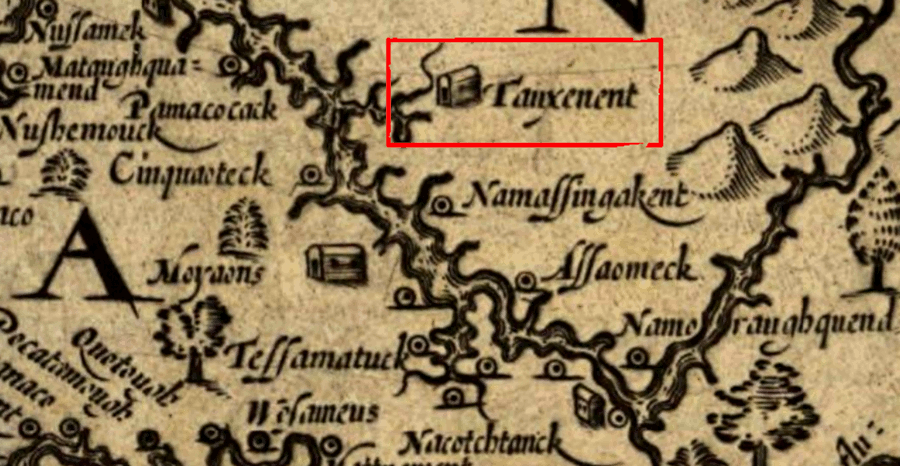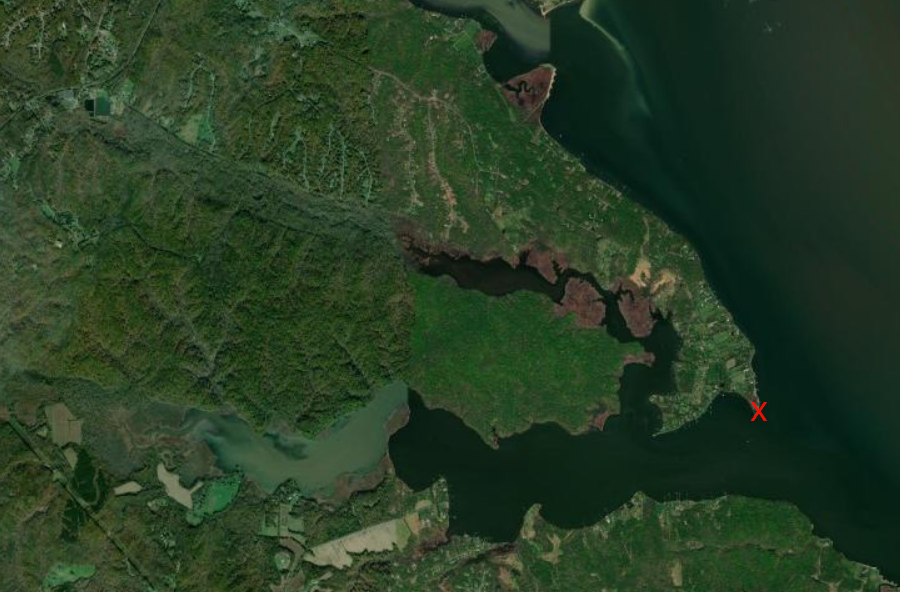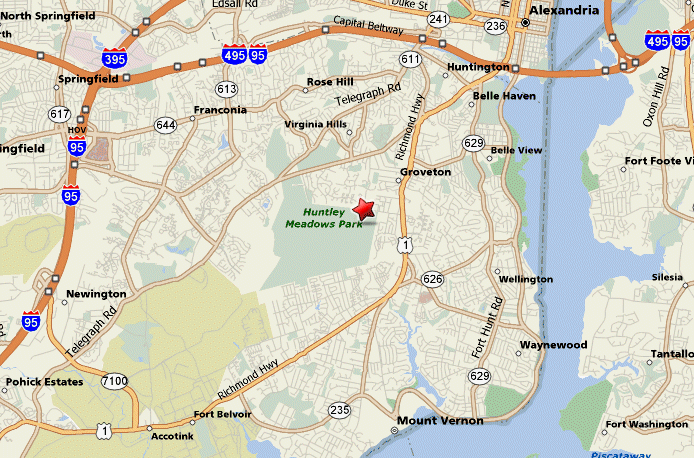
John Smith documented the location of the main Moyumpse/Dogue town, Tauxenent, with the symbol of a king's house
Source: Library of Congress, Virginia (by John Smith, 1624)
The first settlers in Northern Virginia were Native Americans who arrived about 15,000 years ago, or even earlier. When they first arrived, these immigrants were people without bows and arrows, without agriculture, without a written language - just like the other people on the earth living in Africa, Europe, and Asia at that time.
In 1608, when the first European reached Northern Virginia, the Moyumpse (also known by the English as the "Dogues") occupied what is now eastern Prince William County. The main town, Tauxenent, was at the mouth of the Occoquan River. The term Dogue may have been an insulting name used by rival tribes to the south.1
The Moyumpse/Dogue were not part of Powhatan's paramount chiefdom. They were closely associated with neighbors such as the Piscataways, located across the Potomac River in what is now Maryland. The local chief was subservient to an "tayak" who exerted control from what is now Prince Georges County.

John Smith documented the location of the main Moyumpse/Dogue town, Tauxenent, with the symbol of a king's house
Source: Library of Congress, Virginia (by John Smith, 1624)
We still use many of the place names of the original Northern Virginians: Occoquan ("at the end of the water"), Marumsco ("at the island rock"); Quantico ("by the long stream"). One Piscataway town was Nacochtank - known today as Ancostia.
"Dogue" (as in Dogue Creek, near Mount Vernon) is probably a corrupted version of the original name Tauxenent. It is unlikely that the English captured all the syllables in the Algonquian place names AND got the translation correct in John Smith's short visit, or even in later trading expeditions. Claims about the original meaning of "Occoquan" and other places should be taken with a grain of salt?
John Smith discovered a richly-textured society in Virginia. The technology of the Native Americans relied upon wood, stone, and bone tools. This was dramatically different from the Europeans, who had great skills in working with metals.
The Moyumpse/Dogue lived in a rough neighborhood. They controlled access to valuable protein, especially fish in the river. The Susquehannock tribe threatened the Moyumpse/Dogue from the north, while a rival power was centered south of the Rappahannock River. East of the Fall Line, one Native American leader who the English called Powhatan exerted some form of control over 30+ tribes.
Powhatan lacked the modern weapons of the English, so he practiced asymmetric warfare when the aliens arrived from Europe. Powhatan did not engage in open warfare very often. His power was control over the delivery of local food supplies, primarily corn and deer meat, to the English settlers in Jamestown. The Native American leader played a sophisticated game of power diplomacy with the English, enabling the European colony to survive but not thrive. This perpetuated Powhatan's access to valuable iron tools, decorative copper/glass, and even firearms manufactured in Europe.
At the northern edge of Powhatan's territory, north of the Rappahannock River, Powhatan's control was weak. When he tried to limit trade by Jamestown-area tribes, the English sailed north into the Potomac River to acquire enough food to keep the colony alive. It was on one of those trips in 1613 when the chief of the Patawomek tribe, Japasaws, conspired with Captain Samuel Argall and helped the English capture Pocahontas.

the chief of the Patawomeck tribe helped the English capture Pocahontas near the mouth of Potomac Creek
Source: ESRI, ArcGIS Online
English settlement destabilized the Native American societies in Northern Virginia, Maryland, and Pennsylvania. In addition, European diseases may have killed as much as 90% of the original Virginia residents, disrupting traditional lifestyles and communities. The Dogues who survived the diseases ultimately were forced off their lands by English occupation of Northern Virginia.
The Tauxenent tribe in Northern Virginia has not survived as an intact, organized community. There are 8 tribes recognized officially by the state, but none are located north of the Rappahannock River.
Where did the "Dogues" go? A few may have moved south to join the Rappahannocks, south and east of Fredericksburg. However, that group was disrupted by English settlement before tobacco farms were carved from the wilderness in Northern Virginia. Moving southeast would have been moving towards the danger, not away from it.
Most likely, those individual Native Americans who survived European diseases and low-scale frontier warfare migrated across the Potomac River to join the Piscataways. Some may have joined the Suquehannock tribe in Pennsylvania, or even ended up in Shawnee villages along the Ohio River. The genes of the original Northern Virginia settlers may survive in modern bodies, mixed with genes from other tribes and immigrants from Europe/Africa, but the unique Dogue identity is no longer a presence in Northern Virginia. Other than place names, there are almost no reminders of the original settlers of Northern Virginia.
With all the focus on historical sites and tourism in Virginia... can you identify any historic sites associated with Native Americans in Northern Virginia? Any museums, or reconstructed villages? Any historic signs on the sides of the clogged highways?
Archeologists have documented many sites, but typically the artifacts they find are chipped stones or broken pieces of pottery. See The Hartwell Site artifacts. Note the unique code "44FX1847" for that site. 44 stands for the state of Virginia, FX stands for Fairfax County, and 1847 indicates that 1,846 other archeologic sites were documented in the county before this site was recorded. Clearly, archeologic sites are not rare in our area... if we look for them.
However, the bark- and reed-covered dwelling units used by the Dogues rotted away long ago, leaving at best some stains in the soil where the original wooden framework for the houses have rotted away. It's hard to get landowners excited about protecting dirt with stains and "lithic debris," the waste chips of rock created when a Native American toomaker manufactured "points" (including arrowheads) over the last 10,000-15,000 years.
It's even more difficult to prevent landowners from constructing buildings on such sites. Archeologists may get a chance to excavate and salvage artifacts before construction removes all evidence of earlier settlement, but the Native American remnants end up in drawers at consultant offices or storage rooms in museums. Documentation of pre-historical sites is written in the arcane larguage of archeologists. You may see some shards of pottery and chipped stone tools under glass at visitor centers, but few exhibits "bring to life" the story of the earliest human inhabitants of Northern Virginia.

Huntley Meadows Park - one of many places once occupied by Native Americans
Source: Mapquest
Read about the Dogues in Huntley Meadows Park: A Little History by Shirley Scalley. Think the Native Americans lived only in what today are protected parks... or have we built modern subdivisions and office parks right on top of many Native American housing units and farms where corn, squash, and beans were once raised?
Also, read the November, 2007 issue of The Datum Point. The material about Seneca Park (on the Potomac River, between Algonquian and Riverbend regional parks) shows how the minimum requirements to find archeological evidence of Native American sites might be a factor in our failure to identify prehistorical sites in Northern Virginia.